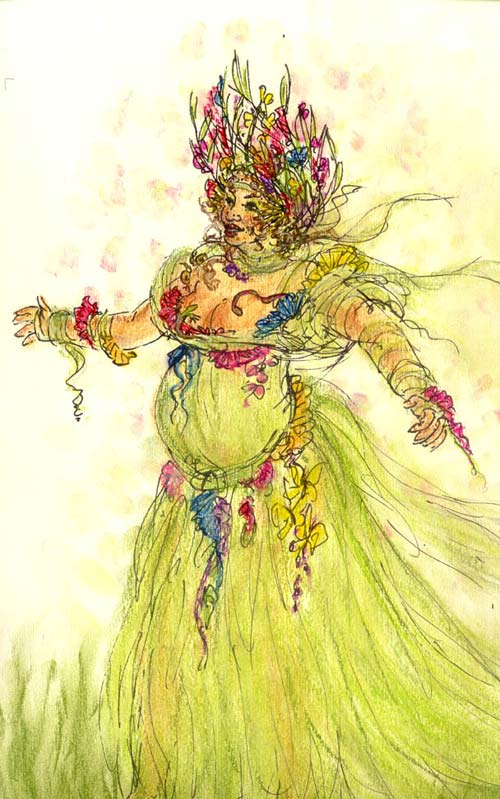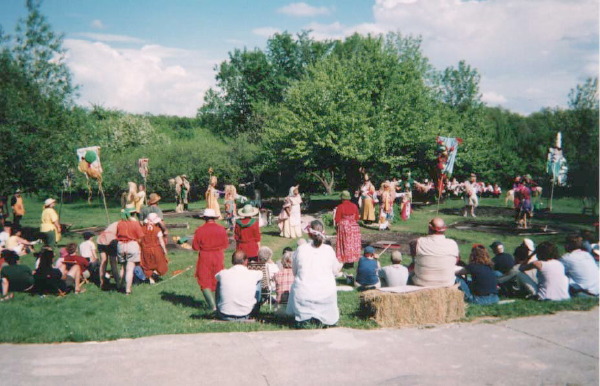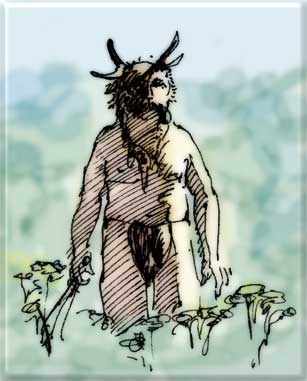"My idea was that two principal characters, a man and a woman, would engage in a search for one another through a labyrinth of different cultures and social twistings almost as if they represented the split halves of the same being...They might return with various guises and different names but the quest for unity and the homeland they were seeking would always be the same."
"Without man the world was born and without him it will end"
He relates a legend of the Princess of the Stars who, listening from the heavens, hears the cry of Wolf and falls to Earth. How Wolf, frightened, wounds her. How she is captured by the 3-Horned Enemy and taken to the bottom of the lake. With the help of the Dawn Birds, Wolf begins his search for the Princess, a search that will take the two through many lives and places. The Wolf, the Three-Horned Enemy and the Sun are represented by giant puppet structures built onto large canoes. The Dawn Birds are winged dancers, also in canoes.
The Princess of the Stars was originally presented on a small lake outside Toronto in 1981 by New Music Concerts, then remounted in 1985 for the Banff School of Fine Arts summer festival on a remote lake in Banff National Park. Over 5000 people made the pre-dawn trek to see the Banff spectacle during the three mornings it was presented. Patria Music/Theatre Projects (the organization that is set up to produce the Patria works) remounted Princess of the Stars in September,1997 in the Haliburton Forest and Wildlife Reserve.
[Banff 1985 - bp nichol as the Presenter. Photo by Jerrard]
[more]
Co-Produced in 1987 by the Canadian Opera Company and The Shaw Festival.
[Toronto 1987 - D.P. Costume drawing by Diana Smith]
top
"Ariadne...from time to time we practice witchcraft"
"In Patria 2, we encounter the aberrational time of dreams or of the mental patient's mind; at times it stands still like dough in a bowl; at other times everything erupts and history is made in milliseconds. I wanted to create a work like a dream, no up or down, before or after, beginning or end, but only flow, musical flow, the flow of noises, of voices, near, distant, unintelligible."
Originally produced by Stratford Festival, Ontario in 1972. Remounted by Autumn Leaf Performance at the DuMaurier Theatre Centre in Toronto in 1993.
[Toronto 1993 - Shock Therapy Machine. Drawing by Jerrard]
top
"Step right up"
For the balance of the performance the audience is free to wander the grounds at will, much like at a traditional fair. There are games and hucksters, strolling entertainers and booths of all sorts. There are tents with displays and three large tent theatres with small performances, tickets to which may only be obtained by winning a game or providing the correct answer to a question. The audience becomes aware that everything they encounter points to the eventual reunion of the Hero and Heroine.
Presented as a workshop production in 1987 and as a full production the following year by Patria Music/Theatre Projects and the Peterborough Festival of the Arts, in Peterborough, Ontario.
[Peterborough 1988 - Philip Drube as Wolfie. Photo and drawings
by Jerrard]
[more]
top
First produced by the Festival de Liège, Belgium in 1989 and remounted in 1992 by Autumn Leaf performance.
[Toronto 1992 - Theodore Gentry as Hermes. Photo by André
Leduc]
[more]top
"There comes a time when everything must be told simply"
"The dancing floor could be raked up to the palace so that the open spaces of various depths and configurations beneath would also serve as resonators for the dancers' footsteps, or at any rate for objects forcefully struck on the surface, each area resonating differently according to the depth and size of the cavity beneath it... ...I have given the male chorus poles to strike on the floor with the intention of utilizing this feature, and various dancers could also have poles, for instance in the Dance of the Double Axe. For this idea to be truly effective the labyrinth would have to be constructed along 'musical' lines. Each chamber or tunnel would have its distinct Eigenton and the various zones of the stage above could be played almost like a giant marimba."
The only production to date has been a concert version with orchestra, chorus, actors and projected slides of conceptual drawings.
[Left: Elder with voice-altering mask and sound sculpture costume
- Concept sketch by Diana Smith.
Right: Pasiphae and the Bull - Concept sketch by Jerrard]
[more]top
You are not permitted to look directly at Ra, but you may touch the sun with your face
Following the journey of the sun god of ancient Egypt from his death in the evening, through the underworld of night to be reborn in the morning, this all-night opera/theatre experience takes place in real time. The audience members become initiate priests of the god RA, to the extent that each one is given a robe, headdress and an amulet with one of the seventy-five names of the sun god. They are taught to recognize scents associated with the various gods they will encounter. They learn chants to help overcome the great serpent Apophis. The journey of RA is their journey and they too are reborn with the dawn.
"Finding venues for Patria works is never easy and finding a site for RA was especially difficult, since the action was to be itinerant and called for twenty-five to thirty locales, both indoors and outdoors"
In taking a work out of the controlled environment of an equipped theatre, we always have to make compromises. The site must transform to meet the demands of the work and the work itself often goes through an adjustment to take advantage of the opportunities presented by the physical attributes of the site. RA more than any of the Patria works has been shaped by the nature of the locations in which it was performed. Each time we are fortunate enough to be able to mount a Patria spectacle, we get a little closer to achieving an ideal marriage of site and concept, one which can produce a profound transformation in both the audience and in the creative artists.
Produced by Comus Music Theatre in and around The Ontario Science Centre, Toronto, Canada in 1983 and in various locations in Leiden, Holland as part of the Holland Festival in 1985.
[RA - Ontario Science Centre, Toronto 1983, Donald Carr as RA
- photo by Shin Sugino]
[more] top
What lies beyond is full of marvels an unrealities, a land of poets and fabulists, of doubts and uncertainties. Plutarch, Life of Theseus
Under construction [more]
 The
setting is the great T'ang dynasty of China (A.D. 618--907). While the presentation
makes many historical references and includes many authentic Chinese elements,
the story and the treatment are original.
The
setting is the great T'ang dynasty of China (A.D. 618--907). While the presentation
makes many historical references and includes many authentic Chinese elements,
the story and the treatment are original.
The Cinnabar Phoenix is a mythical bird, sent by the gods to live in a palace on earth as a symbol of harmony and peace. The Warring States, however, fought to capture the Phoenix, but it vanished together with the palace to be replaced by a Lake of Dragons. Each year the emperor Wei Lu comes to the site to mourn the loss of the palace and the sacred bird. Alchemical experiments are performed with the hope of recovering the ancient era of harmony; but it is not until a Blue Man arrives from an unknown country with a gift that the chemistry works and the Palace and the Cinnabar Phoenix are restored.
The work is performed on and around a small lake with lifesize puppets and takes place at sunset and after dark on a summer evening. [more]
top  The
audience arrives at sunset at the edge of a forest to be met by a group of children,
lamenting the loss of their companion Ariane, who has been carried away into
the forest by Marsh Hawk. Earth Mother asks the Flower Spirits to assist the
children in finding her. Their quest leads them (and the audience) deep into
the darkening forest where they discover Murdeth the Wizard, who intends to
use Ariane to lure Fenris the Wolf into a trap. Fenris protects the forest,
but Murdeth wants to have it cut down and sold for lumber.
The
audience arrives at sunset at the edge of a forest to be met by a group of children,
lamenting the loss of their companion Ariane, who has been carried away into
the forest by Marsh Hawk. Earth Mother asks the Flower Spirits to assist the
children in finding her. Their quest leads them (and the audience) deep into
the darkening forest where they discover Murdeth the Wizard, who intends to
use Ariane to lure Fenris the Wolf into a trap. Fenris protects the forest,
but Murdeth wants to have it cut down and sold for lumber.
With the help of some fairy spirits the children manage to foil Murdeth's plan, but in the course of the action, Ariane is transformed into a Birch Tree. Earth Mother explains that their soul-mate must remain in the forest as a protection against trees being needlessly destroyed, and that with her branches she will also shelter the animals from danger.
In The Enchanted Forest children lead adults back through the strange and miraculous world of their own childhood.
[Earth Mother costume design Diana Smith]
top
 The
Spirit Garden celebrates the cycle of planting and harvesting - birth, maturing,
death and rebirth. The work takes the form of the ritual planting of a real
garden by the audience and consists of two parts: Spring and Harvest.
The
Spirit Garden celebrates the cycle of planting and harvesting - birth, maturing,
death and rebirth. The work takes the form of the ritual planting of a real
garden by the audience and consists of two parts: Spring and Harvest.
The garden is prepared by the Gardeners long before the date of the performance.
When the audience arrives for the Spring section, they are divided into seed
groups and are given their instructions on what they will be expected to do.
The seed groups process into the garden where, after a final preparation of
the soil, they will plant their seeds amid ritual dances and singing. 
Throughout the summer the Gardeners attend the garden and harvest it in the fall. The Harvest section of the Spirit Garden takes place near or on Hallowe'en All Souls Night and consists of a ritual burning of the remains of the garden before passing it over to Winter, who arrives with his Four Winds to take possession of it until next spring. The audience then proceeds indoors and the Spirit Garden closes with a ritual banquet at which the produce of the garden is consumed.
[images from the 2001production at the St. Norbert Art Centre, Winnipeg
above: Spring, below: Harvest]
top
Performed annually in August at the Haliburton Forest and Wildlife Reserve
in Ontario, the Patria Epilogue unites many of the themes that have recurred
throughout the cycle, culminating with the return of the Princess to the stars
and Wolf being awarded the moon by Sun Father. The work, which takes the form
of an elaborate ritual performance in wilderness forest, lasts for eight days.
The same participants return each year to camp in eight clans at four campsites.
The work is self-perpetuating and self-financed by the members, who pledge to
return each year. Further information can be obtained from:
R. Murray Schafer
Indian River
Ontario K0L 2BO Canada
[Tapio]
This site will be expanded as resources allow. We wish to thank the Ontario Arts Council and the Canada Council for their generous support.
We would appreciate any comments and will reply to your email.
jerrard@patria.org
Return to home, The top of this page, The Patria
Design Project Introduction, Order or Chaos